Krump Stars' Alter Egos Demand Attention, Offer Insights Into Past
Heroically posed and larger-than-life, a krumper's alter ego both demands the audience's attention and conveys a dancer's style and story.
So You Think You Can Dance judge and choreographer Christopher "Lil' C" Toler and Marquisa "Miss Prissy" Gardner – featured in the 2005 krump documentary Rize -- are krump's respective king and queen. The royal duo will lead roughly a dozen dancers in an original show they created for University of Southern California's Visions & Voices series program, The Underground: From Streets to the Stage, to celebrate krump's 10th anniversary. The free event is 8 p.m. Wednesday at USC's Bovard Auditorium.
The promotional posters for Underground could be mistaken for an advertising campaign for the next super hero blockbuster. Who are these people? Miss Prissy is the photographer behind this gallery of alter egos for which each dancer chose his or her own costume, struck the pose and set up the shot.
In an unassuming North Hollywood dance studio, they broke from rehearsal to talk about image, who they are when they dance, why they krump and how what they will look like on stage will reveal their stories, matching inner to outer lives.
Marquisa "Miss Prissy" Gardner
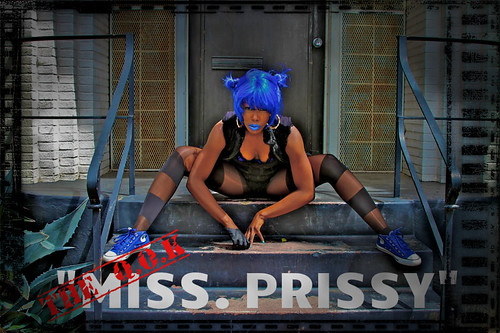
"For me my alter ego is kind of like an Avenger kind of situation. I want to say like Black Widow. She's kind of the vixen in the Avengers. … She's the one that can be easily mistaken because of what her exterior looks like, but she's hard and gritty on the inside. So I imagine that's what my alter ego gives. You see a physically fit young woman who's very dainty and girly, but when the music hits, I'm masculine, gritty and grimy. You would never think of that if you saw me walking in the grocery store."
Christopher "Lil' C" Toler

"I am the King of Krump. I rule this prefecture of style. ... The thing about being king is it's not about being the best, it's about being the best equipped for the job. The person who is able to motivate his loyal subjects and those who reside within the kingdom. I believe that a king is not hasty, he's not impulsive, he's not impetuous. He's very strategic developing a certain formula. He's not quick to act, but he's definitely quick to think.
"...When it comes to krump, I am the first person ever to verbally articulate the style, and I'm the first person to ever deliver it (and) distribute it to the masses and to those who are not familiar with styles indigenous to urban culture.
"… Growing up in the hood, feeling that you have to rise above the wicked wiles and tribulations of being in a corridor of California where the statistics dictate the entire existence based upon the choices that are available to you and the arts that you're exposed to, the inspiration (isn't) there. It's usually all about destruction. So we're trying to influence people to create rather than destroy. That's why I've been labeled the king because I'm the person who makes all of the decisions."
Larry "Ruin" Combs
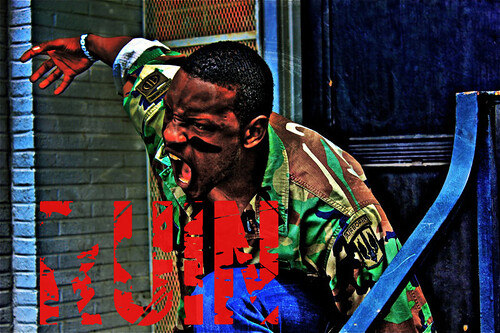
"I have a couple (of alter egos), but the one I'm using for the show is Ruin. That's my primary name, the one I started with. … The name came about through history. I like history. There was this thing called ruins of the Alps, and the name just stuck with me. The way I portray the dance style with the name, is it's real rugged and a heavyset name. Ruins are something that have been destroyed. With my lifestyle and things I've been through, I've been knocked down at times. I'm constantly trying to build myself back up, but I'm still in ruins. That's exactly how I am. I've been through a lot of things, but I'm still standing."
Jo'Artis "Mijo" Ratti
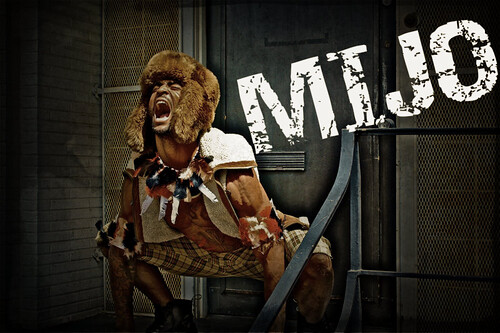
For the character that I tried to come with for the show, I have this vest on that was more tribal and beasty kind of character. My mindset was thinking of Beast and Wolverine from X-Men. That's kind of how I was trying to dress from the top up. On the bottom … I added some feathers and that had more of the tribal feel. It was a little mix between Beast, Wolverine and some tribal situation, but I'm still trying to work on it. I'm still trying to develop the character. I'm trying to build it within building a style of dance to go with it. I wanted to try and simulate an actual beast, so if I'm dancing totally outside the character, upright, I wanted to signal in the beast or the dog comes in and starts to move around (on all fours.)"
Deidra "Krucial" Cooper-Jenkins

"Krucial is a liberator. So she frees people's minds from what they're used to seeing (and) from what they're used to feeling. She frees people from the restraints that bound them in dance or in life. You know, sometimes we don't show all of our emotions. we kind of bottle them up. Krucial makes it ok to let it go. And — representing for the women of course — she's this Amazon character super hero (who) doesn't take it from anybody. So she's very empowering. She is a giant. She can move a mountain.
"Some people dance because they want to impress the next person, and at times you don't let it all out. Through Krucial, I'm able to let out stuff that's been on my heart or been on my mind since 2004 or 2003. Krucial is definitely a liberator and releases it. Then she shares her energy with people and tries to resurrect them and free them so they can feel better."
Manny "Xclusive" Fernandez
I was always pretty underestimated as a dancer, so everybody always kind of kept me to the darkness. So (what I created) was like a lethal weapon. … Hence the mask and the grey paint to look like an assassin. My Clark Kent would be very calm, very cool, collected and whenever someone would want to put a hit out on me, I would put a hit on him first, and morph into my character. My personal life in dancing, that's how it was. People would just think, 'he's just another dude.' But little by little I would take people out, without them even knowing. … That's where I got the idea for this character. It's completely different from the way I am. I'm a very nice individual, but at the same time when I dance, I'm very serious and I just might take you out. At the end of the day, you're not going to beat me. That's the character I wanted to represent."
One of the first things Christopher "Lil' C" Toler will tell young krumpers is to look inside them to find their own alter ego.
"Anyone can dance, and everybody can look like one another," Toler said. "But (when) you develop your own individual style … your movement becomes signature, and that's where that alter ego comes into play."
However, finding that alter ego can be a lifelong process. Toler said he advises dancers to find that seed and then nurture and develop it over time. The alter ego, he said, comes from tapping into personal experiences both positive and negative.
"Your alter ego is the person that has helped you be triumphant over having to grow up around drugs, alcohol, gangs, shootings, violence, killing — all of that," Toler said. "Your alter ego is the one that has rose out of the ashes because it is a collage of everything you have incurred and gone through.
Though the process can be a long one, he said the fully formed alter ego becomes a source of personal strength both in life and dance.
"You can always refer to that alter ego when things get too tough and the turmoil gets to be a little too much, just too tumultuous, so you cop that alter ego and then you resort to your art because your art is all you have."
--Ricky O’Bannon
Darren "Outrage" King
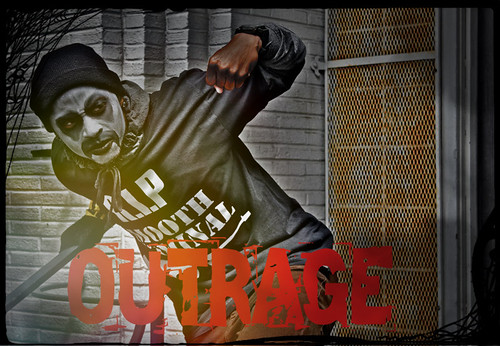
"My character has the black-and-white face on (from the movie) "Dead Presidents." Pretty much I took that whole character of a crook. I'm a very happy person personality-wise. So I took that and flipped it so that when I dance I'm more of an aggressor. If I'm battling somebody, … I want them (to feel) that they're never going to be able to match what I'm doing. When I'm dancing, I'm stealing everything. I'm taking the music, I'm taking the crowd, I'm taking the oohs and ahhs. I'm not going to dance, I'm going to make the music dance to me. … I portray the crook. I portray the bad guy. But out of dancing and krump I'm more of a happy, joyous person. … I never really had a whole lot of friends growing up. I was an army brat always moving around. So I took the image of not really having any friends and said I'm stealing everything because back then I didn't have anything. I didn't have a horrible life, but I had a hard life and that's a way to cope with that. I took that and made it into my character now."
Christopher "Worm" Lewis
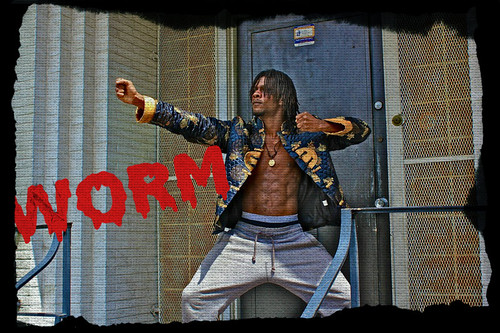
"I don't want to say that I came up with the style or anything. It's more like the style found me. I've been in krump pretty much from the start. As a person, I've always been interested in anime, Japanese art and of course the kung fu aspect of everything. It's always just given me a reverence for martial arts. One of my biggest influences has to be Bruce Lee. Another big one is Michael Jackson, and another big one is Bob Marley. I try to combine that omega triangle and meet in the center of that triangle. I had to learn more of myself. At first I focused more on my martial arts thing and then I focused more on the krump thing. I wanted to just do me. But 'me' consists of all three of those things and a multitude more. So I was just like let me try to put all of this together into one story. … It took me a whole lifetime to fully get it. I'm 21 years old. It took me 21 years to get to where I am here. … I just maybe realized it a few years ago."
Charles "King Charles" Parks
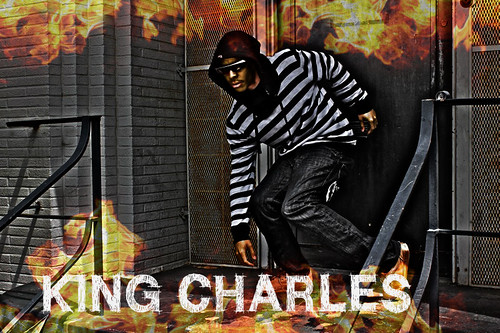
"My alter ego is basically King Charles. The regular guy is Charles Parks. … But King Charles is a surprise. In some sorts he's a creepy surprise. In my first appearance in the whole entire show, I come in as this slow, swift, back-and-forth, sneaky character that you don't really know what to expect from. Especially based on his attire that he's wearing, but then when he gets into full action, you notice he has this ability to move very fast, clean and technical with his feet and lower body. It's a very unfamiliar style to most people. In actuality the style comes from Chicago footwork, and that's what I really execute. That's what I bring to the entire show as far as my character is concerned, this fast, swift experienced foot-working ability. And then I bring my character into it too as far as being this weird-moving, energy-having at all times, that's me: King Charles."
Britton "Briddy" Shaw
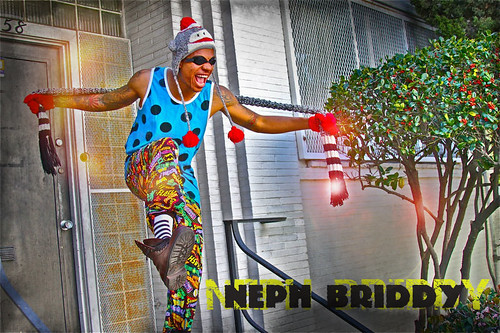
"His name is Tyrone. My style is really animated, very colorful, very bright. I'm really a goofy person, but on the other side I'm very serious. I can have a tie on, get really serious and share wisdom with people. I have two characters, basically. One moment I will be feeling like a cartoon character, bouncing off walls. Then the next moment I will be in the corner, just quiet and to myself. Street dancing is about who you are. Your style is who you are in everyday life. So if I'm quiet one moment, that's going to be the style I have when I dance. I'm going to have a really subtle style, very clean cut. And then other moments I have a real crazy style. … That's just my personality, I can be two different people."
Storyboard
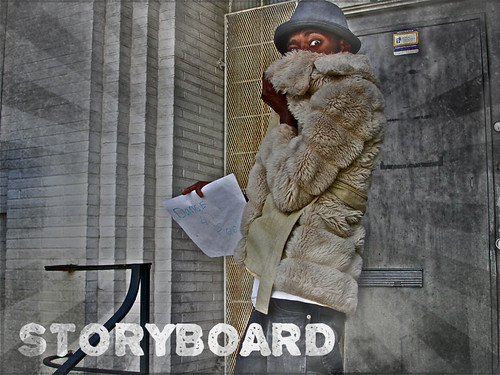
"Originally when I was about 11 or 12 I had this character (called) the Professor. The Professor was basically the writer who wanted to gesture what he was feeling with physical animation. Over time he evolved into Newton because a lot of my motions and gestures felt like graphic animation. So it turns into me imitating the music through animation. Over the years, Storyboard came about as my process broadened. … It developed over time. Storyboard is my process, (the painter Jean-Michel) Basquiat is my end effect. Storyboard is more of the process. It's like a sketch. It's rough. It may have some masking over it. It's a sequence of pictures that all form an order of life. That's the way animation is. The way it relates to dance is the process of doing that to music. Sketching on the spot to me is a lot like freestyle."
Reach reporter Ricky O'Bannon here.




